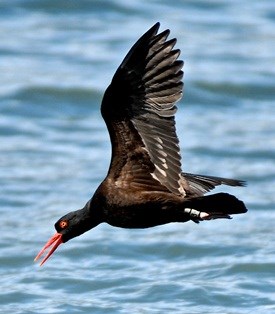
NPS Photo / K. Thoresen Haematopus bachmaniBasic FactsThe black oystercatcher is a large shorebird that inhabits much of the coastal area of the western United States. It is very distinct, with a chicken-sized black body, bright red legs, and a long red beak (about 9 cm). It uses its beak to pry open the shells of mollusks, snails, and the other intertidal invertebrates on which it feeds. Living on secluded and rocky beaches, it can often be seen running in and out of the intertidal zone, looking for food that is left between the crashing of the waves. It is completely dependent on these beach and tidal areas for all aspects of its life (feeding, breeding, nesting, and raising its chicks). It is particularly sensitive to any disturbance and habitat changes in coastal areas, especially those caused by humans. SignificanceBlack oystercatchers are considered a "keystone" species because, as a top predator in the intertidal zone, they affect the number and types of species found in the ecosystem. Their predation of algae-eating snails causes ripples throughout the nearshore ecosystem, making the oystercatcher the "key" to understanding the composition of life in its environment. The black oystercatcher is considered a Management Indicator Species by the park's neighbor to the north, Chugach National Forest, and is a species of concern, both nationally and regionally. ConcernsBlack oystercatchers, their chicks, and their nests, are extremely susceptible to both destruction and predation, especially in areas of heavier visitor use. While the park is currently engaged in studying human and environmental impacts, there are certain steps that we can all take to protect black oystercatchers and other shorebirds. What can you do to help?
ResearchKenai Fjords National Park has a history of conducting and supporting research and monitoring of black oystercatchers and has contributed significantly to the body of knowledge of their life history. We began long term monitoring of black oystercatcher in 2007. During the summer of 2013, biological technician, Sam Stark wrote this blog post which gives us a peek into the life of a black oystercatcher and the research being done. The Southwest Alaska Network (SWAN) maintains a nearshore montioring network in coastal Alaska parks and collaborates with parks and other organizations to observe and understand changes in this ecosystem. Black oystercatchers were selected as a marine nearshore vital sign for continued monitoring. Further information on black oystercatchers and the nearshore monitoring network can be found on the SWAN website. More articles and videos on black oystercatcher research can be found below. |
Last updated: November 14, 2019
